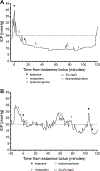Acute Effects of Ketamine on Intracranial Pressure in Children With Severe Traumatic Brain Injury
- PMID: 36825892
- PMCID: PMC11441348
- DOI: 10.1097/CCM.0000000000005806
Acute Effects of Ketamine on Intracranial Pressure in Children With Severe Traumatic Brain Injury
Abstract
Objectives: The acute cerebral physiologic effects of ketamine in children have been incompletely described. We assessed the acute effects of ketamine on intracranial pressure (ICP) and cerebral perfusion pressure (CPP) in children with severe traumatic brain injury (TBI).
Design: In this retrospective observational study, patients received bolus doses of ketamine for sedation or as a treatment for ICP crisis (ICP > 20 mm Hg for > 5 min). Administration times were synchronized with ICP and CPP recordings at 1-minute intervals logged in an automated database within the electronic health record. ICP and CPP were each averaged in epochs following drug administration and compared with baseline values. Age-based CPP thresholds were subtracted from CPP recordings and compared with baseline values. Trends in ICP and CPP over time were assessed using generalized least squares regression.
Setting: A 30-bed tertiary care children's hospital PICU.
Patients: Children with severe TBI who underwent ICP monitoring.
Interventions: None.
Measurements and main results: We analyzed data from 33 patients, ages 1 month to 16 years, 22 of whom received bolus doses of ketamine, with 127 doses analyzed. Demographics, patient, and injury characteristics were similar between patients who did versus did not receive ketamine boluses. In analysis of the subset of ketamine doses used only for sedation, there was no significant difference in ICP or CPP from baseline. Eighteen ketamine doses were given during ICP crises in 11 patients. ICP decreased following these doses and threshold-subtracted CPP rose.
Conclusions: In this retrospective, exploratory study, ICP did not increase following ketamine administration. In the setting of a guidelines-based protocol, ketamine was associated with a reduction in ICP during ICP crises. If these findings are reproduced in a larger study, ketamine may warrant consideration as a treatment for intracranial hypertension in children with severe TBI.
Copyright © 2023 by the Society of Critical Care Medicine and Wolters Kluwer Health, Inc. All Rights Reserved.
Conflict of interest statement
Dr. Betters’ institution received funding from the National Institutes of Health (R61HL151951). Dr. Wellons disclosed the off-label product use of ketamine for intracranial pressure. Dr. Slaughter received funding from the Department of Pediatrics for statistical support. The remaining authors have disclosed that they do not have any potential conflicts of interest.
Figures




Comment in
-
The Evolution of Ketamine in Severe Pediatric Traumatic Brain Injury, From Contraband to Promising Neuroprotectant?Crit Care Med. 2023 May 1;51(5):677-680. doi: 10.1097/CCM.0000000000005826. Epub 2023 Apr 13. Crit Care Med. 2023. PMID: 37052437 No abstract available.
Similar articles
-
Comparison of Intracranial Pressure Measurements Before and After Hypertonic Saline or Mannitol Treatment in Children With Severe Traumatic Brain Injury.JAMA Netw Open. 2022 Mar 1;5(3):e220891. doi: 10.1001/jamanetworkopen.2022.0891. JAMA Netw Open. 2022. PMID: 35267036 Free PMC article.
-
Effectiveness of ketamine in decreasing intracranial pressure in children with intracranial hypertension.J Neurosurg Pediatr. 2009 Jul;4(1):40-6. doi: 10.3171/2009.1.PEDS08319. J Neurosurg Pediatr. 2009. PMID: 19569909 Clinical Trial.
-
Effectiveness of Pharmacological Therapies for Intracranial Hypertension in Children With Severe Traumatic Brain Injury--Results From an Automated Data Collection System Time-Synched to Drug Administration.Pediatr Crit Care Med. 2016 Mar;17(3):236-45. doi: 10.1097/PCC.0000000000000610. Pediatr Crit Care Med. 2016. PMID: 26673840 Free PMC article.
-
Is there an upper limit of intracranial pressure in patients with severe head injury if cerebral perfusion pressure is maintained?Neurosurg Focus. 2003 Dec 15;15(6):E2. doi: 10.3171/foc.2003.15.6.2. Neurosurg Focus. 2003. PMID: 15305838 Review.
-
Opioids and cerebral physiology in the acute management of traumatic brain injury: a systematic review.Brain Inj. 2019;33(5):559-566. doi: 10.1080/02699052.2019.1574328. Epub 2019 Jan 29. Brain Inj. 2019. PMID: 30696281
Cited by
-
Intracranial Pressure and Its Related Parameters in the Management of Severe Pediatric Traumatic Brain Injury.Adv Neurobiol. 2024;42:3-19. doi: 10.1007/978-3-031-69832-3_1. Adv Neurobiol. 2024. PMID: 39432035 Review.
-
Ketamine for Critically Ill Patients with Severe Acute Brain Injury: A Systematic Review with Meta-analysis and Trial Sequential Analysis of Randomized Clinical Trials.Neurocrit Care. 2025 Apr;42(2):610-621. doi: 10.1007/s12028-024-02075-2. Epub 2024 Jul 31. Neurocrit Care. 2025. PMID: 39085508
-
Case report: Invasive neuromonitoring in status epilepticus induced hypoxic ischemic brain injury.Front Neurol. 2023 Nov 30;14:1284098. doi: 10.3389/fneur.2023.1284098. eCollection 2023. Front Neurol. 2023. PMID: 38099068 Free PMC article.
-
Clinical outcomes of ketamine in patients with traumatic brain injury: A systematic review.Int J Crit Illn Inj Sci. 2024 Jul-Sep;14(3):160-175. doi: 10.4103/ijciis.ijciis_36_24. Epub 2024 Sep 20. Int J Crit Illn Inj Sci. 2024. PMID: 39512554 Free PMC article. Review.
-
Ketamine as adjunctive or monotherapy for post-intubation sedation in patients with trauma on mechanical ventilation: A rapid review.Afr J Emerg Med. 2023 Dec;13(4):313-321. doi: 10.1016/j.afjem.2023.10.002. Epub 2023 Nov 10. Afr J Emerg Med. 2023. PMID: 38033380 Free PMC article. Review.
References
-
- Dewan MC, Mummareddy N, Wellons JC 3rd, Bonfield CM. Epidemiology of Global Pediatric Traumatic Brain Injury: Qualitative Review. World Neurosurg. 2016;91:497–509.e1. - PubMed
-
- Centers for Disease Control and Prevention. National Center for Health Statistics: Mortality Data on CDC WONDER. Accessed 2022. Available from: https://wonder.cdc.gov/mcd.html.
-
- Kochanek PM, Tasker RC, Carney N, Totten AM, Adelson PD, Selden NR, et al. Guidelines for the Management of Pediatric Severe Traumatic Brain Injury, Third Edition: Update of the Brain Trauma Foundation Guidelines. Pediatr Crit Care Med. 2019;20(3S Suppl 1):S1–s82. - PubMed
-
- O’Lynnger TM, Shannon CN, Le TM, Greeno A, Chung D, Lamb FS, et al. Standardizing ICU management of pediatric traumatic brain injury is associated with improved outcomes at discharge. J Neurosurg Pediatr. 2016;17(1):19–26. - PubMed
-
- Shein SL, Ferguson NM, Kochanek PM, Bayir H, Clark RS, Fink EL, et al. Effectiveness of Pharmacological Therapies for Intracranial Hypertension in Children With Severe Traumatic Brain Injury--Results From an Automated Data Collection System Time-Synched to Drug Administration. Pediatr Crit Care Med. 2016;17(3):236–45. - PMC - PubMed
Publication types
MeSH terms
Substances
Grants and funding
LinkOut - more resources
Full Text Sources
Medical

